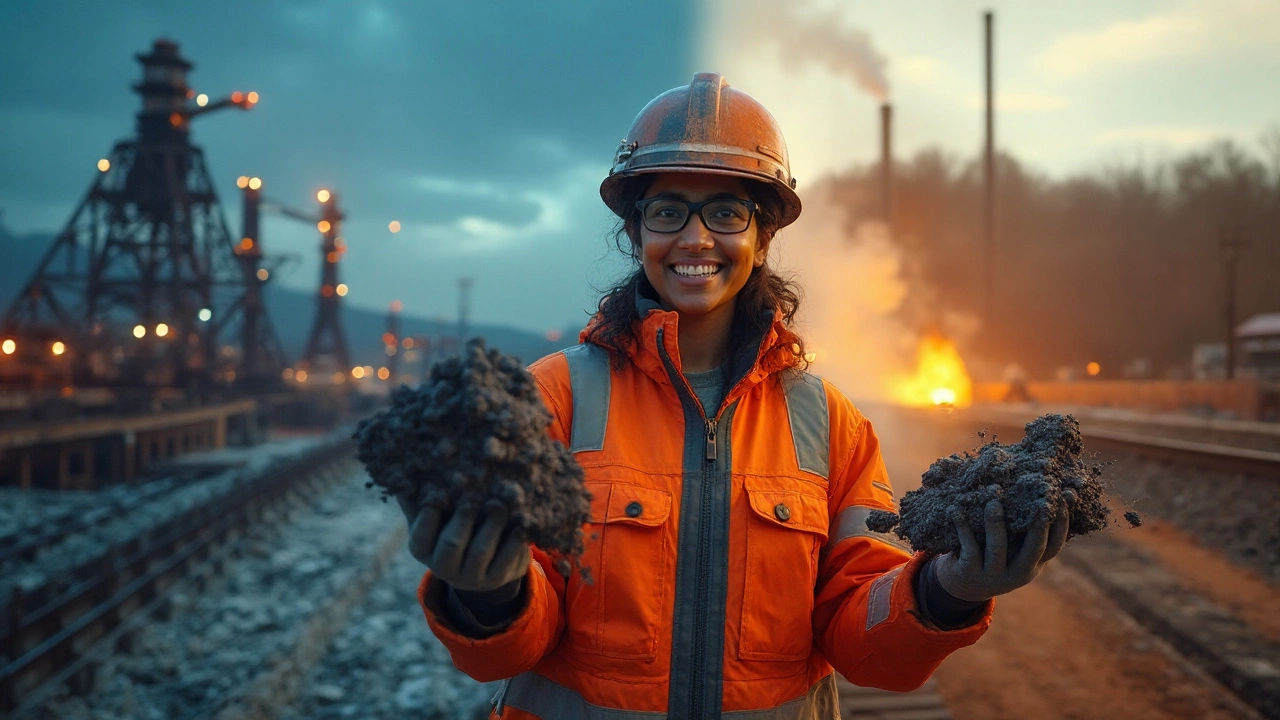If you just need the name, here it is: Pittsburgh. It’s the city Americans most associate with iron and steel. But if you want to sound sharp in a quiz, an interview, or a classroom, there’s more nuance. Birmingham, Alabama, also has a strong claim thanks to its rare mix of iron ore, coal, and limestone in one place. I’ll give you the quick answer, explain the why, and show you when Birmingham (or others) is the smarter pick.
TL;DR
- Best single answer: Pittsburgh - nicknamed the “Steel City,” home to Carnegie Steel and U.S. Steel.
- Also valid in context: Birmingham, Alabama - “Pittsburgh of the South,” built on local iron ore, coal, and limestone.
- Other heavyweights: Gary (IN), Cleveland-Youngstown (OH), Bethlehem (PA), Chicago (IL).
- Memory hook: If the question says “famous nickname,” say Pittsburgh. If it says “raw materials in one city,” think Birmingham.
- Today’s twist: U.S. steel output is dominated by modern electric-arc-furnace hubs across the Midwest and South, not just old mill towns.
The Steel City: Why Pittsburgh became America’s iron-and-steel icon
Pittsburgh earned its reputation the hard way: by making an enormous share of America’s steel for much of the late 19th and early 20th centuries. The name sticks because the city lived and breathed mills - you could see it in the skyline, the river barges, the football team’s name, and the fortunes of the region. If a teacher or trivia host wants “the U.S. city known for iron and steel,” Pittsburgh is the safe, widely accepted answer.
Why Pittsburgh? Three practical reasons came together:
- Fuel and feed: Western Pennsylvania had abundant coal, which was turned into coke, the key fuel for blast furnaces. Iron ore arrived by rail and water from the Great Lakes region. Limestone for flux was close enough to source.
- Rivers and rails: The Allegheny and Monongahela meet at Pittsburgh to form the Ohio River. That three-river junction, plus dense rail links, slashed transport costs for heavy raw materials and finished steel.
- Capital and know-how: Andrew Carnegie scaled steelmaking with the Bessemer and open-hearth processes. U.S. Steel, formed in 1901, anchored corporate and technical leadership. Clusters of mills (Homestead, Braddock/Edgar Thomson, Duquesne) built a skilled workforce and supplier ecosystem.
It wasn’t just marketing. Pittsburgh’s mills shaped national infrastructure - rails, bridges, skyscraper beams - and wartime production. If you’re citing sources, the corporate histories of U.S. Steel, the American Iron and Steel Institute’s historical briefs, and regional histories like the Heinz History Center document that central role. In short: the nickname wasn’t hype - it reflected output, investment, and a city’s identity tied to steel.
Still, context matters. When you see the phrase “iron and steel,” your brain might jump to ore deposits as much as mills. That’s where Birmingham shows up - and why some textbooks or teachers offer two “right” answers depending on phrasing.
| City | State | Known as | Peak era | Signature company/mill | Notable fact |
|---|---|---|---|---|---|
| Pittsburgh | Pennsylvania | Pittsburgh steel city | 1880s-1950s | Carnegie Steel → U.S. Steel; Homestead, Edgar Thomson | Iconic “Steelers” name, dense river/rail logistics, major role in wartime steel |
| Birmingham | Alabama | “Pittsburgh of the South” | 1890s-1960s | Sloss, Ensley, Tennessee Coal, Iron and Railroad (later U.S. Steel) | Unusual in having iron ore, coal, and limestone in one district; Sloss Furnaces is a National Historic Landmark |
| Gary | Indiana | Company town for U.S. Steel | 1910s-1970s | Gary Works (U.S. Steel) | Founded by U.S. Steel in 1906 on Lake Michigan for ore-by-laker logistics |
| Cleveland-Youngstown | Ohio | Mahoning Valley mills | 1900s-1970s | Republic, Jones & Laughlin (J&L), Youngstown Sheet & Tube | River and Great Lakes access; pivotal in rolled products and tubes |
| Bethlehem | Pennsylvania | Bethlehem Steel’s home | 1910s-1980s | Bethlehem Steel | Supplied beams for iconic U.S. bridges and buildings; later diversified into shipbuilding |
| Chicago | Illinois | Calumet steel district | 1910s-1970s | South Works (U.S. Steel), Inland Steel | Lake access for ore; large integrated works feeding Midwest industry |
Notice the pattern: The biggest steel towns were either right on raw materials (like Birmingham) or on cheap bulk transport for ore and fuel (the Great Lakes belt). Pittsburgh had the right mix of fuel, water, capital, and timing. That’s why it sticks as the one-word answer.

When Birmingham is the better answer (and how to never get this question wrong)
Many school questions say “Which city in the USA is known for the iron and steel industry?” If you see “iron and steel” together, the writer might be hinting at raw resource geography as much as factory dominance. Birmingham, Alabama, stands out because it had iron ore, coal, and limestone within the same district - a geological jackpot for blast furnaces. This feature made the city a complete iron-and-steel ecosystem, not just a processing hub.
Why Birmingham became a steel center:
- Three inputs, one basin: Red Mountain iron ore, Warrior coal fields, and local limestone reduced transport costs dramatically. Geologists and the U.S. Geological Survey have flagged this co-location as unusual in North America.
- Integrated works: Companies like Tennessee Coal, Iron and Railroad (absorbed by U.S. Steel in 1907) tied mining, coking, and steelmaking together. Sloss Furnaces, now protected by the National Park Service, shows the blast furnace backbone of that era.
- Southern industrialization: Birmingham helped balance America’s industrial map, giving the South its own heavy-industry anchor.
So, which answer should you give when asked out of the blue? Use this quick playbook.
- If the question says “nickname” or sounds pop culture-ish: Say “Pittsburgh - the Steel City.” It’s the cultural and historical default.
- If the question says “iron and steel” and mentions raw materials or the South: Say “Birmingham, Alabama.” Add “thanks to local iron ore, coal, and limestone.”
- If the question mentions Great Lakes or a company town: Consider “Gary, Indiana,” founded by U.S. Steel for ore-by-laker efficiency.
- If it hints at engineering landmarks: “Bethlehem, Pennsylvania,” because of Bethlehem Steel’s beams and bridges.
- Still unsure?: Pittsburgh is safe 9 times out of 10.
Examples to lock it in:
- Quiz card says: “Which city is called the Steel City?” → Pittsburgh.
- Textbook asks: “Which city grew due to local iron ore, coal, and limestone?” → Birmingham.
- Interview asks: “Which city did U.S. Steel build for mill access to Lake Michigan?” → Gary.
- Travel trivia: “Where can you tour historic blast furnaces as a museum?” → Sloss Furnaces, Birmingham.
Cheat sheet (printable memory aids):
- Pittsburgh = nickname + national steel identity.
- Birmingham = raw materials in one place.
- Gary = company town by U.S. Steel.
- Bethlehem = beams/bridges legacy.
- Ohio Valley (Cleveland-Youngstown) = rolled products and tube mills.
Common pitfalls to avoid:
- Don’t assume the biggest historical output equals the only right answer. Context can shift it to Birmingham.
- Don’t confuse “steel mills” (finished or semi-finished steel) with “ironworks” (pig iron from blast furnaces). Some questions stress “iron and steel” to zero in on integrated districts.
- Don’t forget modern steel has shifted south and west - today’s production map doesn’t look like 1955.

Today’s U.S. steel map: what changed, what stayed (and a mini‑FAQ)
Steelmaking in the U.S. has reinvented itself. The towering integrated mills that defined Pittsburgh and Gary aren’t the only story anymore. Since the 1980s, the industry has leaned into electric arc furnaces (EAFs) that melt scrap (and, more recently, pig iron or direct-reduced iron) with far less energy and capital than traditional blast furnaces. This shift scattered capacity to places with cheap electricity, modern logistics, and strong automotive demand - often in the Midwest and South.
What that means in practice:
- EAF dominance: Most U.S. steel now comes from EAFs. Producers like Nucor and Steel Dynamics lead the pack. Industry summaries from the American Iron and Steel Institute and company annual reports outline this shift.
- New clusters: Mississippi County, Arkansas (Osceola area), has become a powerhouse with flat-rolled mills feeding auto steel demand. Alabama (Tuscaloosa, Mobile region) and Texas host growing footprints too.
- Integrated still matters: Cleveland-Cliffs and U.S. Steel operate large blast-furnace complexes along Lake Michigan and Lake Erie for specific grades, including automotive sheet and tinplate.
- Cleaner input mix: Direct-reduced iron (DRI) plants in places like Louisiana support low-residual EAF feedstock, a step toward lower emissions steels.
If you’re learning the heritage cities for school, here’s a fast checklist that still holds up in 2025:
- Heritage nickname? → Pittsburgh.
- Raw materials in one place? → Birmingham.
- Company-built mega mill? → Gary.
- Bridge beams and iconic projects? → Bethlehem.
- Ohio’s industrial belt? → Cleveland-Youngstown.
Mini‑FAQ
- Is Pittsburgh still a major steel producer today?
Not the way it was mid‑20th century. Much of the heavy integrated capacity has closed or transformed. The region still has important facilities (like Edgar Thomson), specialty producers, research, and corporate offices. But the center of gravity for volume has shifted to EAF hubs in the Midwest and South. Company disclosures (U.S. Steel, Cleveland‑Cliffs) and AISI data show the wider trend. - Why did the industry move?
Cheaper, flexible EAF technology; the rise of high‑quality scrap and DRI; logistics advantages closer to customers (especially auto plants); and environmental upgrades. Bureau of Labor Statistics series on iron-and-steel employment tracks the long-term restructuring. - What’s the difference between iron and steel in this context?
“Iron” usually means pig iron from a blast furnace. “Steel” is refined iron with controlled carbon and alloy content, made in basic oxygen furnaces or electric arc furnaces. Cities known for “iron and steel” often had both parts on one site (like Birmingham’s integrated works). - Which city had the highest single-site mill?
Gary Works (U.S. Steel) ranks among the largest integrated complexes in North America. It was sited for lake‑borne ore and rail to Midwest consumers. Company histories detail its peak scale. - What city should I answer on a standardized test?
If the test is U.S.-centric and offers one blank, write “Pittsburgh.” If the question emphasizes local raw materials - or it’s a Southern U.S. curriculum - “Birmingham” may be expected. Read the clues.
Credible sources to name‑drop if asked (no need to look them up right now):
- American Iron and Steel Institute (industry stats and history summaries)
- U.S. Steel corporate history (Carnegie Steel, Gary Works)
- National Park Service - Sloss Furnaces National Historic Landmark (Birmingham)
- U.S. Geological Survey - Great Lakes iron ore shipments and resource maps
- Heinz History Center / regional Pittsburgh industrial histories
Quick practice prompts to test yourself right now:
- “Which city is best known as the Steel City?” → Pittsburgh.
- “Which Southern city had iron ore, coal, and limestone together?” → Birmingham.
- “Which city did U.S. Steel build around a massive mill on Lake Michigan?” → Gary.
- “Which city’s company supplied beams for famous U.S. bridges?” → Bethlehem.
Pro tips for learners and job‑seekers:
- If you have five seconds in a quiz, go with Pittsburgh.
- If an interviewer asks follow‑ups, add a second city to show range: “Pittsburgh is the Steel City, but Birmingham is famous because it had all three raw materials.”
- If you’re touring, Pittsburgh offers heritage sites and museums; Birmingham’s Sloss Furnaces gives you a face‑to‑face with blast furnace scale.
One-liner you can keep in your notes: Pittsburgh is the city Americans mean when they say “the Steel City.” Birmingham is the city geologists point to when they talk about iron ore, coal, and limestone living side by side.
If you want to go deeper, explore how electric‑arc furnaces, direct‑reduced iron, and automotive steel grades are reshaping the map - you’ll see why modern steel hot spots now include Arkansas, Alabama, and Texas alongside the classic Great Lakes belt. But for the original question on your screen? Say “Pittsburgh,” and you’ll be right more often than not.

